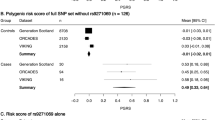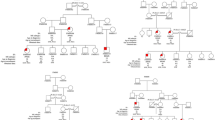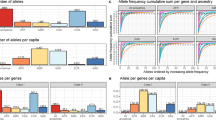Abstract
Association studies have greatly refined the understanding of how variation within the human leukocyte antigen (HLA) genes influences risk of multiple sclerosis. However, the extent to which major effects are modulated by interactions is poorly characterized. We analyzed high-density SNP data on 17,465 cases and 30,385 controls from 11 cohorts of European ancestry, in combination with imputation of classical HLA alleles, to build a high-resolution map of HLA genetic risk and assess the evidence for interactions involving classical HLA alleles. Among new and previously identified class II risk alleles (HLA-DRB1*15:01, HLA-DRB1*13:03, HLA-DRB1*03:01, HLA-DRB1*08:01 and HLA-DQB1*03:02) and class I protective alleles (HLA-A*02:01, HLA-B*44:02, HLA-B*38:01 and HLA-B*55:01), we find evidence for two interactions involving pairs of class II alleles: HLA-DQA1*01:01–HLA-DRB1*15:01 and HLA-DQB1*03:01–HLA-DQB1*03:02. We find no evidence for interactions between classical HLA alleles and non-HLA risk-associated variants and estimate a minimal effect of polygenic epistasis in modulating major risk alleles.
This is a preview of subscription content, access via your institution
Access options
Subscribe to this journal
Receive 12 print issues and online access
$209.00 per year
only $17.42 per issue
Buy this article
- Purchase on Springer Link
- Instant access to full article PDF
Prices may be subject to local taxes which are calculated during checkout




Similar content being viewed by others
References
Jersild, C., Svejgaard, A. & Fog, T. HL-A antigens and multiple sclerosis. Lancet 1, 1240–1241 (1972).
Ligers, A. et al. Evidence of linkage with HLA-DR in DRB1*15-negative families with multiple sclerosis. Am. J. Hum. Genet. 69, 900–903 (2001).
International Multiple Sclerosis Genetics Consortium. A high-density screen for linkage in multiple sclerosis. Am. J. Hum. Genet. 77, 454–467 (2005).
Kwon, O.J. et al. HLA class II susceptibility to multiple sclerosis among Ashkenazi and non-Ashkenazi Jews. Arch. Neurol. 56, 555–560 (1999).
International Multiple Sclerosis Genetics Consortium. Risk alleles for multiple sclerosis identified by a genomewide study. N. Engl. J. Med. 357, 851–862 (2007).
Baranzini, S.E. et al. Genome-wide association analysis of susceptibility and clinical phenotype in multiple sclerosis. Hum. Mol. Genet. 18, 767–778 (2009).
De Jager, P.L. et al. Meta-analysis of genome scans and replication identify CD6, IRF8 and TNFRSF1A as new multiple sclerosis susceptibility loci. Nat. Genet. 41, 776–782 (2009).
Australia and New Zealand Multiple Sclerosis Genetics Consortium (ANZgene). Genome-wide association study identifies new multiple sclerosis susceptibility loci on chromosomes 12 and 20. Nat. Genet. 41, 824–828 (2009).
International Multiple Sclerosis Genetics Consortium & Wellcome Trust Case Control Consortium 2. Genetic risk and a primary role for cell-mediated immune mechanisms in multiple sclerosis. Nature 476, 214–219 (2011).
Patsopoulos, N.A. et al. Genome-wide meta-analysis identifies novel multiple sclerosis susceptibility loci. Ann. Neurol. 70, 897–912 (2011).
International Multiple Sclerosis Genetics Consortium. Analysis of immune-related loci identifies 48 new susceptibility variants for multiple sclerosis. Nat. Genet. 45, 1353–1360 (2013).
Leslie, S., Donnelly, P. & McVean, G. A statistical method for predicting classical HLA alleles from SNP data. Am. J. Hum. Genet. 82, 48–56 (2008).
Dilthey, A. et al. Multi-population classical HLA type imputation. PLOS Comput. Biol. 9, e1002877 (2013).
Patsopoulos, N.A. et al. Fine-mapping the genetic association of the major histocompatibility complex in multiple sclerosis: HLA and non-HLA effects. PLoS Genet. 9, e1003926 (2013).
Marrosu, M.G. et al. Dissection of the HLA association with multiple sclerosis in the founder isolated population of Sardinia. Hum. Mol. Genet. 10, 2907–2916 (2001).
Sanna, S. et al. Variants within the immunoregulatory CBLB gene are associated with multiple sclerosis. Nat. Genet. 42, 495–497 (2010).
Barcellos, L.F. et al. Heterogeneity at the HLA-DRB1 locus and risk for multiple sclerosis. Hum. Mol. Genet. 15, 2813–2824 (2006).
Dyment, D.A. et al. Complex interactions among MHC haplotypes in multiple sclerosis: susceptibility and resistance. Hum. Mol. Genet. 14, 2019–2026 (2005).
Marrosu, M.G. et al. Interaction of loci within the HLA region influences multiple sclerosis course in the Sardinian population. J. Neurol. 253, 208–213 (2006).
Lincoln, M.R. et al. Epistasis among HLA-DRB1, HLA-DQA1, and HLA-DQB1 loci determines multiple sclerosis susceptibility. Proc. Natl. Acad. Sci. USA 106, 7542–7547 (2009).
Hedström, A.K. et al. Smoking and two human leukocyte antigen genes interact to increase the risk for multiple sclerosis. Brain 134, 653–664 (2011).
Gregersen, J.W. et al. Functional epistasis on a common MHC haplotype associated with multiple sclerosis. Nature 443, 574–577 (2006).
Evans, D.M. et al. Interaction between ERAP1 and HLA-B27 in ankylosing spondylitis implicates peptide handling in the mechanism for HLA-B27 in disease susceptibility. Nat. Genet. 43, 761–767 (2011).
Strange, A. et al. A genome-wide association study identifies new psoriasis susceptibility loci and an interaction between HLA-C and ERAP1. Nat. Genet. 42, 985–990 (2010).
Kirino, Y. et al. Genome-wide association analysis identifies new susceptibility loci for Behcet's disease and epistasis between HLA-B*51 and ERAP1. Nat. Genet. 45, 202–207 (2013).
Dilthey, A.T., Moutsianas, L., Leslie, S. & McVean, G. HLA*IMP—an integrated framework for imputing classical HLA alleles from SNP genotypes. Bioinformatics 27, 968–972 (2011).
Field, J. et al. A polymorphism in the HLA-DPB1 gene is associated with susceptibility to multiple sclerosis. PLoS ONE 5, e13454 (2010).
Yang, J., Lee, S.H., Goddard, M.E. & Visscher, P.M. GCTA: a tool for genome-wide complex trait analysis. Am. J. Hum. Genet. 88, 76–82 (2011).
Mathieson, I. & McVean, G. Differential confounding of rare and common variants in spatially structured populations. Nat. Genet. 44, 243–246 (2012).
Masterman, T. et al. HLA-DR15 is associated with lower age at onset in multiple sclerosis. Ann. Neurol. 48, 211–219 (2000).
Goyette, P. et al. High-density mapping of the MHC identifies a shared role for HLA-DRB1*01:03 in inflammatory bowel diseases and heterozygous advantage in ulcerative colitis. Nat. Genet. 47, 172–179 (2015).
Lang, H.L. et al. A functional and structural basis for TCR cross-reactivity in multiple sclerosis. Nat. Immunol. 3, 940–943 (2002).
Manolio, T.A. et al. Finding the missing heritability of complex diseases. Nature 461, 747–753 (2009).
de Bakker, P.I. et al. A high-resolution HLA and SNP haplotype map for disease association studies in the extended human MHC. Nat. Genet. 38, 1166–1172 (2006).
Schwarz, G.E. Estimating the dimension of a model. Ann. Stat. 6, 461–464 (1978).
Roxburgh, R.H. et al. Multiple Sclerosis Severity Score: using disability and disease duration to rate disease severity. Neurology 64, 1144–1151 (2005).
Acknowledgements
We thank the individuals, nurses and referring physicians who participated in this study. This project was supported by the US National Institutes of Health (NS049477, NS26799, R01NS032830, RC2NS070340, R01NS067305 and RC2GM093080), the Wellcome Trust (085475/B/08/Z, 085475/Z/08/Z, 084702/Z/08/Z and 098051), the UK MS Society (857/07, 861/07, 862/07, 894/08, 898/08 and 955/11), the UK Medical Research Council (G0700061), Naomi Branson, the Sainsbury Foundation, NMSS (RG 4198-A-1 and 4680-A-1, FG 1938-A-1, JF2138A1, JF-2137A4 and South Florida chapter), the Cambridge National Institute for Health Research (NIHR) British Research Council (BRC), DeNDRon, the Bibbi and Niels Jensens Foundation, the Swedish Brain Foundation, the Swedish Research and County Council, the Knut and Alice Wallenberg Foundation, the Swedish Heart-Lung Foundation, the AFA Foundation, the Foundation for Strategic Research, the Stockholm County Council (592229), the Strategic Cardiovascular and Diabetes Programmes of Karolinska Institutet, the Swedish Council for Working Life and Social Research, INSERM, ARSEP, AFM, GIS-IBISA, BMBF, KKNMS (01GI0917), Deutsche Forschungsgemeinschaft (530/1-1), Munich Biotec Cluster M4, the Fidelity Biosciences Research Initiative, FWO-Vlaanderen, Research Fund KU Leuven (OT/11/087), the Belgian Neurological Society, the Belgian Charcot Foundation, Gemeinnützige Hertie Stiftung, CRPPMS University Zurich, the Danish MS Society, the Danish Council for Strategic Research, the Center of Excellence for Disease Genetics of the Academy of Finland, the Sigrid Juselius Foundation, the Helsinki University Central Hospital Research Foundation, FISM (2011/R/14), Fondazione Cariplo (2010-0728), MIUR (PRIN08), CRT Foundation Turin, the Italian Ministry of Health (502/92), the Italian Foundation for Multiple Sclerosis, INSPE, the Multiple Sclerosis Association of Oslo, the Norwegian Research Council (143153 and 143410), the South-Eastern Norwegian Health Authorities (51852/ILM) and the Australian National Health and Medical Research Council (633275 and 1053756).
We acknowledge the use of samples from the British 1958 Birth Cohort DNA collection (UK Medical Research Council, G0000934 and Wellcome Trust, 068545/Z/02), the UK National Blood Service controls, the Vanderbilt University Medical Center's BioVU DNA Resources Core (US National Institutes of Health, 1UL1RR024975-01), CRB-REFGENSEP, Norwegian Bone Marrow Registry controls, the Norwegian Multiple Sclerosis Registry and Biobank, NARCOMS Registry (CMSC), the Brigham and Women's Hospital PhenoGenetic Project and Academy of Finland DILGOM (136895, 263836 and 118065).
The GWAS made use of external control data from the popgen biobank, Swedish Breast Cancer study, HYPERGENES, CHOP, the Swedish CAD study, BRC-REFGENSEP, Pitié-Salpêtrière CIC, Généthon, the Wellcome Trust Sanger Institute, the University of Miami John P. Hussman Institute, ICM, the Norwegian Multiple Sclerosis Registry and Biobank, the SNP Technology Platform in Uppsala, Sweden, and the University of California, San Francisco. Full acknowledgments are included in the Supplementary Note.
Author information
Authors and Affiliations
Consortia
Contributions
A.C., A.O., A.S., B.D., B.F., B.H., B.T., C.G., C.M.L., D.A.H., D. Booth, D. Buck, E.G.C., F.M.-B., F.Z., G.S., H.F.H., I.K., IIBDGC, J.H., J.L.H., J.L.M., J.R.O., J.S., L.A., P.L.D.J., S.D'A., S.L.H., S.S., T.M.C.B. and T.O. were involved with case ascertainment and phenotyping. A.G., A.O., B.F., D. Booth, D. Buck, F.M.-B., H.B.S., H.F.H., I.K., J.L.M., J.R.O., M.B., P.L.D.J., S.D'A. and S.S. processed the DNA. A.O., B.F., D.A.H., H.B.S., IIBDGC, J.L.M., M.B., P.L.D.J. and S.S. conducted and supervised the genotyping of samples. A.H.B., A.T.D., C.A.A., C.C.A.S., C.C., D.K.X., G.M., J.L.H., J.L.M., L.F., L.J., L.M., M.B., N.A.P., P.D., P.L.D.J., P.-A.G., S.E.B., S.L., S.S. and T.S.S. performed the analysis. A.G., A.H.B., A.J.I., A.O., A.T.D., B.D., B.F., B.H., C.A.A., C.C.A.S., C.C., C.G., C.M.L., D. Booth, D. Buck, D.K.X., E.G.C., F.M.-B., F.Z., G.M., H.B.S., H.F.H., I.K., J.B., J.L.H., J.L.M., J.S., J.W., L.J., L.M., M.B., N.A.P., P.D., P.L.D.J., S.D'A., S.L., S.S., T.M.C.B. and T.S.S. collected and managed the project data. A.C., A.H.B., A.J.I., A.S., B.H., C.A.A., C.A.D., C.C.A.S., C.C., C.G., C.M.L., D.A.H., E.G.C., F.M.-B., F.Z., G.M., G.S., H.F.H., J.B., J.H., J.L.H., J.L.M., J.R.O., J.S., J.W., K.E.A., L.A., L.J., M.A.P.-V., M.B., N.A.P., P.D., P.L.D.J., S.D'A., S.L., S.L.H., S.S., T.M.C.B., T.O. and T.S.S. contributed to the study concept and design. All authors reviewed and approved the final manuscript.
Corresponding author
Ethics declarations
Competing interests
A.T.D., P.D., S.L. and G.M. are partners in Peptide Groove, LLP, which commercializes HLA*IMP.
Integrated supplementary information
Supplementary Figure 1 Effects of incorporating uncertainty in classical HLA allele prediction.
Comparison of P values and odds ratios estimated for each cohort for all classical HLA allele effects shown in Figure 1 under methods taking account of uncertainty in classical HLA allele imputation (y axis) and not taking into account uncertainty (x axis). The values reported are from a model including additive and non-additive effects for DRB1*15:01 and principal components, in addition to the indicated allele. DOM, dominant term; REC, recessive term; INT, interaction term.
Supplementary Figure 2 Comparison of manually curated and automated approaches for building a model of HLA risk for multiple sclerosis.
Summary of the results from the model selection procedures (without interaction search) using manual curation (left), automatic model search with alleles at four-digit resolution (middle) and automatic mega-analysis augmented with alleles grouped at two-digit resolution and by sharing of amino acid residues. Alleles are shown in order of inclusion in each approach and were matched between approaches by LD (the Pearson correlation coefficient across the entire cohort is shown and groups are identified by color). At each stage, models with additive (no superscript), dominant (D), recessive (R) and general (G) risk were tested. The allele used to refer to each group is indicated in bold. Effects identified that were better explained by interactions between other alleles are underlined. Note that DRB1_AA57.S is a near-perfect proxy (r = 0.95) for the presence of either DRB1*08:01 or DRB1*13:03, although a model with independent effects for the two alleles provides better fit. We note also that B_AA326.C is weakly correlated with the presence of B*44:02 (r = 0.26), although the latter remains significant in FEM if the former is included.
Supplementary Figure 3 Evidence for interactions among classical HLA alleles affecting risk for multiple sclerosis.
Quantile-quantile plots showing the distribution of P values in the UK cohort for the interaction term between HLA alleles reported in the full model and other classical HLA alleles. For each test, the full model (i.e., factors shown in Fig. 1 apart from interactions), including non-additive effects for DRB*15:01, DRB1*03:01 and A*02:01, is fitted, along with the potential interaction. Results are shown for the UK cohort only. Note that DPB1*03:01 is shown here rather than the related SNP rs9277565.
Supplementary Figure 4 Evidence for interactions between classical HLA alleles and non-HLA disease-associated variants affecting risk for multiple sclerosis.
Quantile-quantile plots showing the distribution of P values within the UK cohort for the interaction term between HLA alleles reported in the full model and non-HLA SNP variation influencing genetic risk for multiple sclerosis (from ref. 11). For each test, the full model, including non-additive effects for DRB*15:01, DRB1*03:01 and A*02:01, is fitted, along with the potential interaction. Results are shown for the UK cohort only. Note that DPB1*03:01 is shown here rather than the related SNP rs9277565.
Supplementary Figure 5 Interactions between HLA variants and combined non-HLA risk for multiple sclerosis.
The effect of the indicated allele or variant in the UK cohort among individuals stratified into quartiles by a combined non-HLA risk score, obtained by multiplying the odds ratios associated with each genotype carried by an individual at non-HLA loci influencing risk (from ref. 11). The point estimate and 95% confidence interval for effect size are estimated independently for each quartile of non-HLA genetic risk. Dashed and dotted lines indicate the combined point estimate and 95% confidence interval, respectively. HOM, risk for homozygous genotype; DOM, dominance term; INT, interaction term.
Supplementary Figure 6 Conflation between evidence for interactions and a departure from additivity for DRB1*15:01 and A*02:01.
Top, quantile-quantile plots showing the distribution of P values for interaction terms between DRB1*15:01 (left) and A*02:01 (right) and non-HLA variants known to affect risk of multiple sclerosis (from ref.11) under a model where the HLA allele acts additively (on the log-odds scale). Bottom, as above, but where a departure from additivity is included for DRB1*15:01 and A*02:01. Because potential interactions are modeled as an additional additive effect of the associated SNP that only acts in the presence of at least one copy of the HLA allele, deviations from additivity can partly mimic potential interactions with the non-HLA variants.
Supplementary Figure 7 Classical HLA alleles affecting age at onset.
Meta-analysis showing effects of pairs of classical HLA alleles in strong LD (DRB1*15:01–DQB1*06:02 and DRB1*01:01–DQA1*01:01) on age at onset.
Supplementary information
Supplementary Text and Figures
Supplementary Figures 1–7, Supplementary Tables 1–5 and Supplementary Note. (PDF 2332 kb)
Rights and permissions
About this article
Cite this article
the International Multiple Sclerosis Genetics Consortium. Class II HLA interactions modulate genetic risk for multiple sclerosis. Nat Genet 47, 1107–1113 (2015). https://doi.org/10.1038/ng.3395
Received:
Accepted:
Published:
Issue Date:
DOI: https://doi.org/10.1038/ng.3395
This article is cited by
-
Modifiable risk factors for multiple sclerosis have consistent directions of effect across diverse ethnic backgrounds: a nested case–control study in an English population-based cohort
Journal of Neurology (2024)
-
Epstein–Barr virus as a leading cause of multiple sclerosis: mechanisms and implications
Nature Reviews Neurology (2023)
-
The association between disability progression, relapses, and treatment in early relapse onset MS: an observational, multi-centre, longitudinal cohort study
Scientific Reports (2023)
-
Genetic risk score in multiple sclerosis is associated with unique gut microbiome
Scientific Reports (2023)
-
Methyl-CpG-Binding Protein 2 Emerges as a Central Player in Multiple Sclerosis and Neuromyelitis Optica Spectrum Disorders
Cellular and Molecular Neurobiology (2023)



